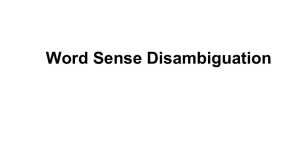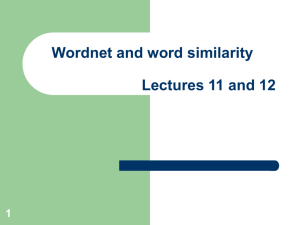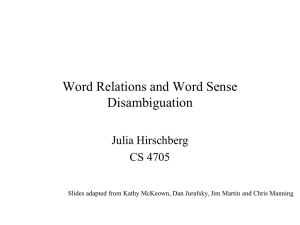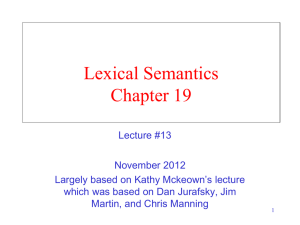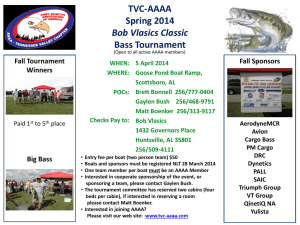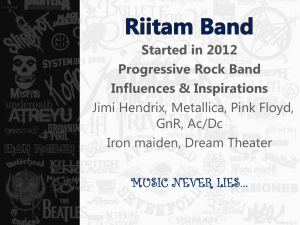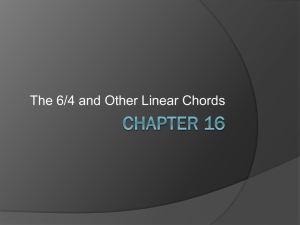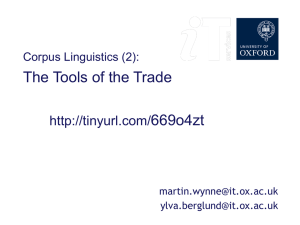15 - School of Computing
advertisement
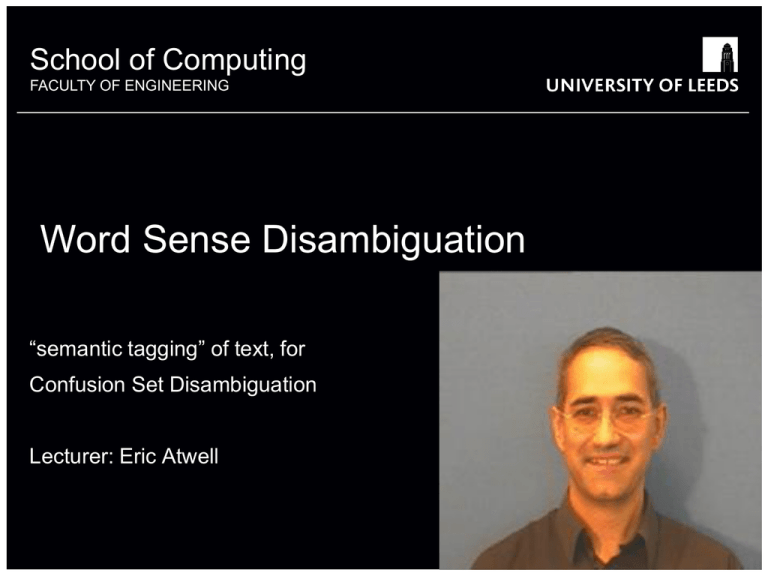
School of Computing
something
FACULTY OF ENGINEERING
OTHER
Word Sense Disambiguation
“semantic tagging” of text, for
Confusion Set Disambiguation
Lecturer: Eric Atwell
Word Sense Disambiguation (WSD)
The WSD task: given
• a word in context,
• A fixed inventory of potential word senses
decide which sense of the word this is. Examples:
• English-to-Spanish MT
• Decide from a set of Spanish translations
• Speech Synthesis and Recognition
• Decide from homographs with different pronunciations like bass and bow
• Confusion set disambiguation {principal,principle}, {to,too,two},
{weather,whether}
• Michelle Banko and Eric Brill 2001 “Scaling to very very large corpora for
natural language disambiguation”
Lexicographers use
SketchEngine
“A word sketch is a one-page, automatic, corpus-derived
summary of a word’s grammatical and collocational
behaviour.”
Sketch Engine shows a Word Sketch or list of collocates or
words co-occurring with the target word more frequently than
predicted by probabilities;
A lexicographer can colour-code groups of related collocates
indicating different senses or meanings of the target word;
With a large corpus the lexicographer should find all current
senses, better than relying on intuition;
For minority languages with few existing corpus resources, eg
Amharic, Sketch Engine is combined with Web-Bootcat, so
researchers can collect their own new Web-as-Corpus for
another language
SketchEngine concordance
Two variants of WSD task
How to automate WSD? Easy and hard versions:
Lexical Sample task
• Small pre-selected set of target words
• And inventory of senses for each word
All-words task
• Every word in an entire text
• A lexicon with senses for each word
• Sort of like part-of-speech tagging
• Except each lemma has its own tagset
Approaches
PoS-tagging disambiguates a few cases
(bank a plane v the river bank)
Supervised Machine Learning of collocation patterns from
sense-tagged corpus
Un- (or Semi-) supervised: no tagged corpus, use linguistic
knowledge from a dictionary
• Overlap in dictionary definitions: Lesk algorithm
• Selectional Restriction rules
Supervised Machine Learning
Approaches
Supervised machine learning approach:
• a training corpus of ?
• used to train a classifier that can tag words in new text
• Just as we saw for part-of-speech tagging
Summary of what we need:
• the tag set (“sense inventory”)
• the training corpus
• A set of features extracted from the training corpus
• A classifier
Supervised WSD 1: WSD
Tags
What’s a tag?
Grammarians agree on Noun, Verb, Adjective, Adverb,
Preposition, Conjunction, …
BUT there is no equivalent set of “semantic tags” which cover
all words in English
WORDNET: a set of SENSES for each word
In NLTK; also online:
http://www.cogsci.princeton.edu/cgi-bin/webwn
WordNet Bass
The noun ``bass'' has 8 senses in WordNet
1.
2.
3.
4.
5.
6.
7.
8.
bass - (the lowest part of the musical range)
bass, bass part - (the lowest part in polyphonic music)
bass, basso - (an adult male singer with the lowest voice)
sea bass, bass - (flesh of lean-fleshed saltwater fish of the family Serranidae)
freshwater bass, bass - (any of various North American lean-fleshed freshwater fishes especially of the
genus Micropterus)
bass, bass voice, basso - (the lowest adult male singing voice)
bass - (the member with the lowest range of a family of musical instruments)
bass -(nontechnical name for any of numerous edible marine and
freshwater spiny-finned fishes)
Inventory of sense tags for bass
Supervised WSD 2: Get a corpus
Lexical sample task:
• Line-hard-serve corpus - 4000 examples of each
• Interest corpus - 2369 sense-tagged examples
• Banko&Brill: auto-generate confusion sets e.g.{to,too,two} in very very
large corpora
All words:
• Semantic concordance: a corpus in which each open-class word is
labeled with a sense from a specific dictionary/thesaurus.
• SemCor: 234,000 words from Brown Corpus, manually tagged with
WordNet senses
• SENSEVAL-3 competition corpora - 2081 tagged word tokens
Supervised WSD 3: Extract
feature vectors
Weaver (1955)
If one examines the words in a book, one at a time as
through an opaque mask with a hole in it one word wide,
then it is obviously impossible to determine, one at a time,
the meaning of the words. […] But if one lengthens the slit
in the opaque mask, until one can see not only the central
word in question but also say N words on either side, then
if N is large enough one can unambiguously decide the
meaning of the central word. […] The practical question is
: ``What minimum value of N will, at least in a tolerable
fraction of cases, lead to the correct choice of meaning for
the central word?''
dishes
bass
washing dishes.
simple dishes including
convenient dishes to
of dishes and
free bass with
pound bass of
and bass player
his bass while
“In our house, everybody has a career and none of them
includes washing dishes,” he says.
In her tiny kitchen at home, Ms. Chen works efficiently, stirfrying several simple dishes, including braised pig’s ears
and chcken livers with green peppers.
Post quick and convenient dishes to fix when your in a
hurry.
Japanese cuisine offers a great variety of dishes and
regional specialties
We need more good teachers – right now, there are only a
half a dozen who can play the free bass with ease.
Though still a far cry from the lake’s record 52-pound bass
of a decade ago, “you could fillet these fish again, and that
made people very, very happy.” Mr. Paulson says.
An electric guitar and bass player stand off to one side, not
really part of the scene, just as a sort of nod to gringo
expectations again.
Lowe caught his bass while fishing with pro Bill Lee of
Killeen, Texas, who is currently in 144th place with two
bass weighing 2-09.
Feature vectors
A simple representation for each observation (each
instance of a target word)
• Vectors of sets of feature/value pairs
• I.e. files of comma-separated values, a line in WEKA .arff
• These vectors should represent the window of words around
the target
How big should that window be?
Two kinds of features in the
vectors
Collocational features and bag-of-words features
• Collocational
• Features about words at specific positions near target word
• Often limited to just word identity and POS
• Bag-of-words
• Features about words that occur anywhere in the window (regardless
of position)
• Typically limited to frequency counts
Examples
Example text (WSJ)
• An electric guitar and bass player stand off to one
side not really part of the scene, just as a sort of
nod to gringo expectations perhaps
• Assume a window of +/- 2 from the target
Examples
Example text
• An electric guitar and bass player stand off to one
side not really part of the scene, just as a sort of
nod to gringo expectations perhaps
• Assume a window of +/- 2 from the target
Collocational
Position-specific information about the words in the window
guitar and bass player stand
• [guitar, NN, and, CC, player, NN, stand, VB]
• Wordn-2, POSn-2, wordn-1, POSn-1, Wordn+1 POSn+1…
• In other words, a vector consisting of
• [position n word, position n part-of-speech…]
Bag-of-words
Information about the words that occur within the window.
First derive a set of terms to place in the vector.
Then note how often each of those terms occurs in a given
window.
Co-Occurrence Example
Assume we’ve settled on a possible vocabulary of 12 words that includes
guitar and player but not and and stand
guitar and bass player stand
• [0,0,0,1,0,0,0,0,0,1,0,0]
• Which are the counts of words predefined as e.g.,
• [fish,fishing,viol, guitar, double,cello…
Semi-supervised
Bootstrapping
What if you don’t have enough data to train a system…
Bootstrap
• Pick a word that you as an analyst think will co-occur with your target
word in particular sense
• Search (grep) through a corpus (eg WWW: Web-as-Corpus?) for your
target word and the hypothesized word
• Assume that the target tag is the right one
Bootstrapping
For bass
• Assume play occurs with the music sense and fish occurs with the fish
sense
• Use each text sample as training data for one or other sense
Sentences extracting using “fish”
and “play”
Classifiers
Once we cast the WSD problem as a classification problem,
then all sorts of techniques are possible
• Naïve Bayes (the easiest thing to try first)
• Decision lists
• Decision trees
• Neural nets
• Support vector machines
• Nearest neighbor methods…
Classifiers
The choice of technique, in part, depends on the set of
features that have been used
• Some techniques work better/worse with features with numerical values
• Some techniques work better/worse with features that have large
numbers of possible values
• For example, the feature the word to the left has a fairly large
number of possible values
Naïve Bayes Test
On a corpus of examples of uses of the word line, naïve
Bayes achieved about 73% correct
Good?
The score is only “meaningful” in comparison to other scores
same task, different classifiers
(to find best classifier)
OR different tasks, same classifier
(to find hardest task)
Decision Lists: another popular method
A case statement….
Learning Decision Lists
Restrict the lists to rules that test a single feature (1decisionlist rules)
Evaluate each possible test and rank them based on how well
they work.
Glue the top-N tests together and call that your decision list.
WSD Evaluations and
baselines
Evaluate against a manually tagged corpus
• Exact match accuracy
• % of words tagged identically with manual sense tags
• Usually evaluate using held-out data from same labeled corpus
Compare accuracy to Baseline(s) and Ceiling
• Baseline: Most frequent sense
• ?Baseline: The Lesk algorithm
• Ceiling: Human inter-annotator agreement
Most Frequent Sense
Wordnet senses are ordered in frequency order
So “most frequent sense” in wordnet = “take the first sense”
Ceiling
“As good as it gets”
Human inter-annotator agreement
• Compare annotations of two humans
• On same data
• Given same tagging guidelines
Human agreements on all-words corpora with Wordnet style
senses
• 75%-80%
Unsupervised Methods
WSD: Dictionary/Thesaurus
methods
The Lesk Algorithm
Selectional Restrictions
NB these are “unsupervised” in Machine Learning terms, in
that, in training data, each instance does NOT have a
class.
This does NOT mean there is “no human intervention” – in
fact, human knowledge is used, encoded in dictionaries
and hand-coded rules; BUT this is not supervised ML.
Original Lesk: pine cone
Dictionary definitions of pine1 and cone3 literally overlap:
“evergreen” + “tree”
So “pine cone” must be pine1 + cone3
Simplified Lesk
Count words in the context (sentence) which are also in the
Gloss or Example for 1 and 2;
Choose the word-sense with most “overlap”
Disambiguation via Selectional
Restrictions
“Verbs are known by the company they keep”
• Different verbs select for different thematic roles
wash the dishes (takes washable-thing as patient)
serve delicious dishes (takes food-type as patient)
Method: semantic attachments in grammar
• Semantic attachment rules are applied as sentences are syntactically
parsed, e.g.
VP --> V NP
V serve <theme> {theme:food-type}
• Selectional restriction violation: no parse
But this means we must:
• Write selectional restrictions for each sense of each predicate – or
use FrameNet
• Serve alone has 15 verb senses
• Obtain hierarchical type information about each argument (using
WordNet)
• How many hypernyms does dish have?
• How many words are hyponyms of dish?
But also:
• Sometimes selectional restrictions don’t restrict enough (Which
dishes do you like ?)
• Sometimes they restrict too much (Eat dirt, worm! I’ll eat my hat!)
Summary
Humans can do WSD, difficult to automate
Lexicographers use concordance (eg from SketchEngine) to
visualize word senses
PoS-tagging disambiguates a few cases
(bank a plane v the river bank)
Supervised Machine Learning of collocation patterns from
sense-tagged corpus
Un- (or Semi-) supervised: no tagged corpus, use linguistic
knowledge from a dictionary
• Overlap in dictionary definitions: Lesk algorithm
• Selectional Restriction rules
